
When investing in gold, you need to understand purity levels. Stamped as .999 or .9999 fine gold, it has 99.9% (.999) to 99.99% (.9999) pure gold, and it is one of the most popular forms in the market.
Fine gold is typically applied in investment-grade bullion, bars, and coins due to its high purity. It does not have major alloying metals that other low-quality gold has, and this is the reason for its unique appearance and greater intrinsic value.
So what makes fine gold different? How is it purified, and why is it so valuable? BOLD assists you in knowing these investors and making sound decisions in the gold market.

Fine gold is a general term used to define the purest form of gold for everyone. They contain .999 (99.9%) and .9999 (99.99%) pure gold. Even though they are different in the millesimal fineness scale, both fineness are considered at 24 Karat gold. The difference in the decimal is caused by the alloys that contribute to the rigidness of the gold bullion.
While unrefined gold alloys have some impurities in them, fine gold has minimal impurities in it, enhancing its value and marketability. Fine gold finds extensive application in bullion and jewelry production. Because of its rarity and purity, fine gold is highly preferred among investors and collectors.
Like bullion is the purest form of precious metal, similarly, fine gold is the purest (almost) form of gold. Fine gold is expressed on the millesimal fineness scale, which is a number of parts per thousand of pure metal in the alloy, by mass.
The most well-known differentiation is .999 (99.9%) and .9999 (99.99%), which is mostly applied to investment bars and coins.
1. 999 (.999) – 99.9% fine gold
2. 9999 (.9999) – 99.99% fine gold
Fine Gold production involves various steps from gold extraction to the refining stage. It starts with the prospecting of gold-bearing ground, followed by mineral processing and extraction to isolate pure gold from the other minerals. Sophisticated methods such as leaching, electrowinning, and smelting achieve the highest possible purity at this point prior to the refinement stage.
1. Gold Mining & Prospecting: Scientists are conducting samples for high concentrations of gold discovery. Methods of mining are open-pit, underground mining, or panning.
2. Extraction & Leaching: Rock that is mined is crushed into powder and combined with water to form a slurry. Leaching tanks separate the gold, which attaches itself to carbon particles.
3. Electrowinning & Smelting: Gold is extracted by an electric current from the leaching solution. Then melted at 2,100°F, and flux was added to burn off impurities.
4. Refining: Scrap gold and Dore bars are melted along with soda ash and borax in a furnace. Refined gold, the final, is assayed and cast into bars for consumption.
| Purity | Percentage | Examples |
|---|---|---|
| .9999 | 99.99% | American Buffalo, Canadian Gold Maple Leaf |
| .999 | 99.9% | Mexican Gold Libertad, Chinese Gold Panda |
| .995 | 99.5% | Valcambi Kilo Gold Bar (LBMA Good Delivery) |
| .99 | 99% | Rarely used, still considered fine gold |
| .986 | 98.6% | Historical Austrian and Hungarian coins |
| .9167 | 91.67% | American Gold Eagles, British Sovereigns |
| .900 | 90% | French & Swiss Napoleon 20 Francs coins |
Investors or collectors can buy American Buffalo, Canadian Gold Maple Leaf, or Mexican Gold Libertad coins from BOLD for the utmost purity and value preservation.
Fine gold is commonly employed in bullion because it is pure and has intrinsic value. It is not impure and holds its value, being very close to the gold spot price and thus favored by investors looking for stability.
As compared to gold jewelry handled repeatedly, fine gold bullion is not handled, keeping it in its soft shape intact and sensitive to the touch. Even investors store it in safe storage devices to keep the metal intact and its value intact in the market.
For outright ownership, a fine gold bullion is a physical asset that can be held in hand. BOLD has an extensive collection of fine gold for collectors and investors.
Fine gold identification includes its purity, its stampings, and its physical characteristics. Fine gold that is pure is generally stamped with a millennial fineness number like .999 or .9999, which represents its level of purity. Fine gold is yellow in color and never tarnishes as the years go by.
Its authenticity can further be determined with tests such as acid testing, gold testing electronic, or XRF testing. Weight and density tests also determine its authenticity because fine gold weighs 19.32 g/cm³ and is heavier than the majority of counterfeit metals.
Selling fine gold to BOLD is simple and secure. Get competitive prices, lock in rates, and ship safely. Fill out a form or call 1-(866)454-BOLD to start your transaction today!
Investing in quality gold promises value and stability for the long term. Its purity is high, making it a darling for investors and collectors. Understanding markings on gold and how to authenticate them supports decision-making. Buying bullion or jewelry means selecting high-purity gold that promises quality and authenticity.
For investors who want to diversify their investment portfolio, BOLD offers a great range of fine gold investment products. It has a unique portfolio function, through which you can easily track and track your gold investments and thus have a hassle-free and secure investment experience.